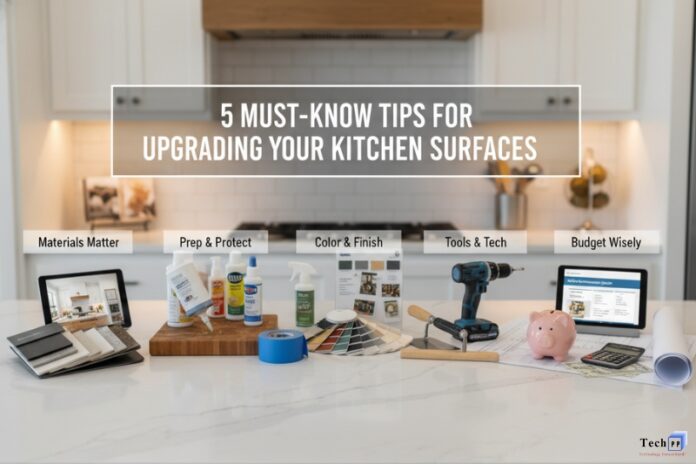Your kitchen surfaces work harder than any other area in your home. They endure daily chopping, hot pans, spills, and countless family gatherings. When these hardworking surfaces start showing their age, it’s time to consider an upgrade that balances functionality with style.
Choose the Right Material for Your Lifestyle
The material you select will determine how your kitchen surfaces perform under daily use. Each option brings distinct advantages and challenges that align differently with various cooking habits and household demands.
Natural Stone Options
Granite remains a popular choice for its durability and unique patterns. Each slab offers one-of-a-kind veining and color variations. Granite countertops like those in Salt Lake City showcase how this material can complement both traditional and contemporary kitchen designs. However, granite requires periodic sealing to prevent stains and bacterial growth.
Marble delivers unmatched elegance and provides an excellent surface for pastry work due to its naturally cool temperature. The trade-off comes in its susceptibility to etching from acidic substances like lemon juice or wine. Marble demands careful maintenance and immediate cleanup of spills.
Engineered Materials
Quartz surfaces combine natural quartz crystals with resins to create a non-porous surface that resists stains and scratches. These engineered slabs offer consistent patterns and colors while eliminating the need for sealing. The manufacturing process allows for a wider range of design options, including styles that mimic natural stone.
Solid surface materials provide seamless installation possibilities and can be shaped into integrated sinks and backsplashes. These surfaces are repairable if damaged and offer good stain resistance, though they’re more susceptible to heat damage than stone options.
Alternative Materials
Concrete surfaces can be customized with various colors, textures, and embedded elements. While initially less expensive, concrete requires proper sealing and may develop hairline cracks over time. The industrial aesthetic appeals to modern kitchen designs.
Butcher block brings warmth and natural beauty while providing an excellent cutting surface. Wood requires regular oiling and careful maintenance to prevent water damage and bacterial growth. Different wood species offer varying levels of hardness and grain patterns.
Set a Realistic Budget and Explore Cost-Effective Solutions
Kitchen surface upgrades can range from a few hundred to several thousand dollars, depending on material choices, kitchen size, and installation requirements. Establishing a clear budget early helps narrow your options and prevents costly surprises.
Understanding Total Project Costs
Material costs typically represent 60-70% of your total budget, with the remainder covering fabrication, delivery, and installation. Premium materials like exotic granites or large-format slabs command higher prices, while more common options offer significant savings without sacrificing quality.
Labor costs vary by region and project complexity. Kitchens with unusual layouts, multiple cutouts, or structural modifications require additional time and expertise. Obtaining detailed quotes from multiple contractors helps establish realistic expectations.
Money-Saving Strategies
Consider using premium materials for high-visibility areas like islands while choosing more economical options for perimeter counters. This approach maximizes visual impact while controlling costs.
Remnant pieces from larger jobs can provide excellent value for smaller projects like bathroom vanities or kitchen islands. Stone yards often sell these pieces at significant discounts.
Timing your project during slower seasons may result in better pricing from contractors and suppliers. Many professionals offer competitive rates during winter months when demand decreases.
Match Your Style and Design Vision
Kitchen surfaces significantly influence your space’s overall aesthetic. The right choice complements existing elements while supporting your design goals, whether you’re aiming for timeless elegance or cutting-edge contemporary style.
Color and Pattern Considerations
Light-colored surfaces create an open, airy feeling and work well in smaller kitchens. They also show dust and crumbs more readily, requiring frequent cleaning. Dark surfaces hide everyday mess better but may show water spots and fingerprints more prominently.
Bold patterns and veining create visual interest but can overwhelm smaller spaces or compete with other design elements. Subtle patterns offer versatility and longevity, adapting well to changing décor over time.
Coordinating with Existing Elements
Your surface choice should harmonize with cabinet finishes, flooring, and backsplash materials. Cool-toned stones pair well with white or gray cabinets, while warm-toned materials complement wood finishes and earth-tone color schemes.
Consider the overall kitchen style when selecting surfaces. Traditional kitchens often benefit from natural stone with classic edge profiles, while contemporary spaces may call for clean-lined materials with minimal detailing.
Plan for Long-Term Maintenance and Durability
Different materials require varying levels of ongoing care. Understanding these requirements upfront helps you choose surfaces that align with your maintenance preferences and busy lifestyle.
Daily Care Requirements
Some materials demand immediate attention to spills and require specific cleaning products. Others handle neglect better but may need periodic professional restoration. Assess honestly how much daily maintenance you’re willing to perform.
Non-porous surfaces generally require less ongoing care than natural stones. However, they may show wear differently over time, with some materials developing a patina that adds character while others show damage more prominently.
Durability Factors
Heat resistance varies significantly among materials. Natural stones generally handle hot cookware better than engineered surfaces, though trivets and cutting boards protect any surface from damage.
Scratch resistance depends on material hardness and surface finish. Polished surfaces often show scratches more readily than honed or textured finishes, though they’re typically easier to clean.
Consider your cooking habits when evaluating durability. Frequent bakers might prioritize surfaces that handle flour and rolling pins well, while avid entertainers might prefer materials that resist wine stains and maintain their appearance under heavy use.
Weigh Professional Installation Against DIY Options
Installation quality directly impacts your surfaces’ performance and longevity. While DIY installation can save money, it requires specific skills, tools, and physical capabilities that many homeowners don’t possess.
Professional Installation Benefits
Experienced installers bring specialized tools, knowledge of local building codes, and insurance coverage that protects against costly mistakes. They can handle unexpected issues like uneven walls or plumbing adjustments that commonly arise during surface installations.
Professional installation typically includes warranties on both materials and workmanship, providing peace of mind and recourse if problems develop. Many material warranties require professional installation to remain valid.
DIY Considerations
Some materials lend themselves better to DIY installation than others. Tile surfaces and some laminate options can be successfully installed by skilled homeowners with appropriate tools and patience.
Heavy materials like stone slabs require multiple people and specialized equipment for safe handling. Attempting DIY installation without proper support can result in injury or material damage that exceeds professional installation costs.
Consider the time investment required for DIY projects. Professional installation typically takes 1-2 days, while DIY projects often extend over several weekends, disrupting your kitchen’s functionality for extended periods.
Conclusion
Upgrading your kitchen surfaces represents a significant investment in your home’s functionality and value. By carefully considering material properties, budget constraints, style preferences, maintenance requirements, and installation options, you can make decisions that enhance your daily cooking experience while supporting your long-term goals.


